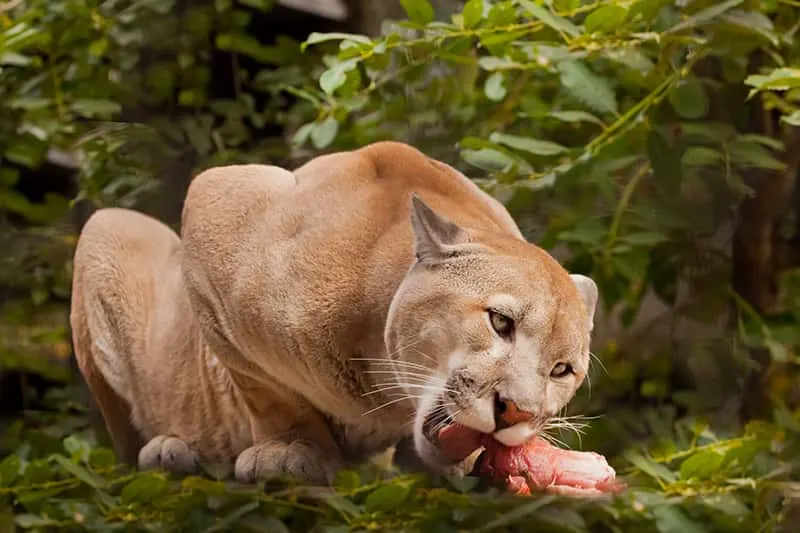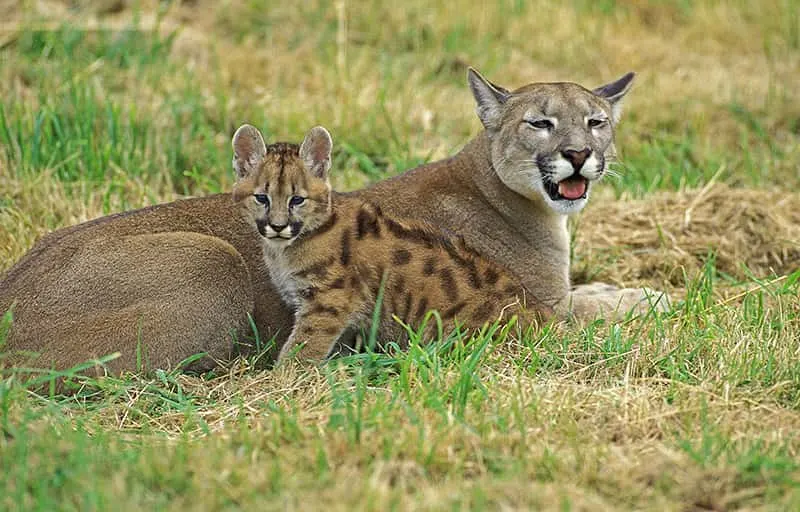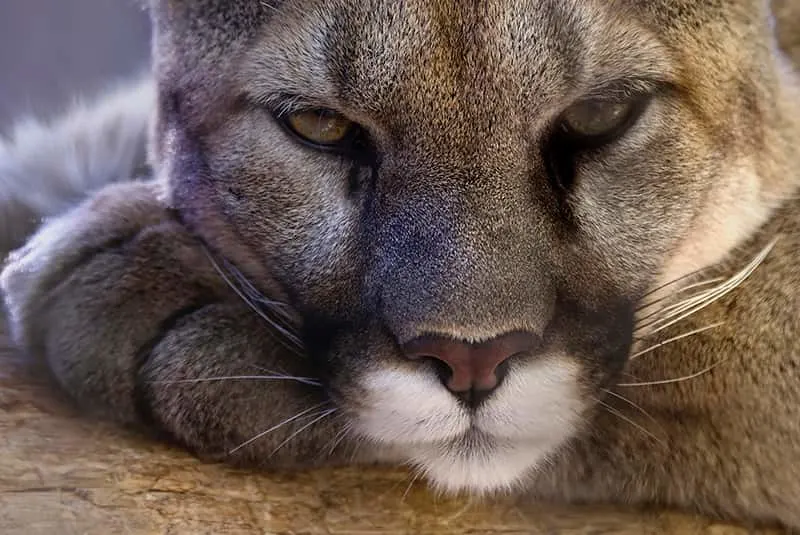Want to learn some cool cougar facts for kids? Learn all about these amazing creatures in this post. We will talk about the cougar’s physical description, diet, offspring, and more!

One of the most interesting cougar facts for kids is that according to the Guinness Book of World Records, a cougar is the mammal with the highest number of different names.
Physical Description
A cougar resembles a large housecat. Cougars have short fur that is grey-brown or reddish brown. Their underside fur is lighter in color than the fur on the rest of their bodies. Cougars are distinguished by black markings on their faces and ears. They also have black-tipped tails.
Cougars have small heads and gold eyes. They have short ears and snouts. A cougar has a powerful jaw. It has a muscular body with a long tail.
Cougars weigh from seventy-five to two hundred and fifty pounds. They grow to be between three and six and a half feet long. Male cougars are larger than females. A cougar’s tail makes up a third to a half of its body length.
Habitat
The Cougar’s range extends from Canada's Yukon area to the Andes mountains in South America. This range includes western North America, Florida, and most of South America. Cougars thrive in all climates, from hot to cold temperatures.
Cougars are very adaptable. They live in woodlands, grasslands, swamps, and deserts. They prefer to live in areas with canyons and dense vegetation.
Habits
A cougar has a wide range of territory. A cougar range is fifty to one hundred and fifty square miles in size. Cougars don't have dens. They seek refuge in different places in their range. These places include caves, rocky outcrops, and places with thick vegetation.
Cougars hunt both during the day and at night. They are most active during the hours of dusk and dawn. Cougars are solitary creatures that roam their territory in search of prey. They stalk, pounce, and attack their prey from behind. Cougars save their leftover prey by covering it with leaves and other debris. They will later return to eat the remaining prey.

Diet
Cougars are carnivores. Cougars prefer deer, but they will eat a wide range of wild animals. Bobcats, raccoons, rabbits, fish, and snails can all be part of a cougar's diet. Cougars also prey on domestic animals such as calves, pigs, and chickens.
Cougars need to eat about twenty pounds of meat a day. How often they hunt is determined by the size of the prey they catch. If a cougar kills a deer for food, it won't have to hunt for another week and a half.
Offspring
Cougars can breed at any time of year. When they are three years old, they begin mating. A cougar mother is pregnant for about three months. She can have up to seven kittens in one litter, but most of the time she only has three or four.
Cougar cubs are born deaf with closed eyes and spotted fur. The cub’s eyes are blue when they open at about two weeks. As cubs grow older, their eyes turn gold, they get the ability to hear, and their spots fade.
The mother cougar starts teaching her cubs to hunt for prey when the cubs are about six months old. The juvenile cubs stay with their mother for as long as two years. Juvenile cougars leave their mothers to find new territory. Female cougars seek territory near their mother's territory. Male cougars seek out territory far from their mother’s.

Classification/taxonomy
Kingdom: Animalia
Phylum: Chordata
Class: Mammalia
Order: Carnivora
Family: Felidae
Genus: Puma
Species: Puma Concolor
History
We don't know very much about how cougars evolved and adapted. Cougars started evolving about eleven million years ago. They entered North America about eight and a half million years ago. Cougars share a common ancestor with the African cheetah and the American jaguarundi.
Predators
Juvenile cougars have many predators. Adult male cougars, golden eagles, bears, and wolves are just a few examples of creatures that prey on young cougars. Adult cougars do not have natural predators. They are at the top of the food chain in their environment.
Cougars face the greatest threat from humankind. Humans have the greatest impact on cougars by causing habitat loss. Cougars are most vulnerable to habitat fragmentation. When roads are built in a cougar’s territory, the cougar finds it difficult to cross into the next piece of its territory. Humans also clear land for agriculture and construction. The cougar’s prey animals leave these developed areas. As a result, there is less prey for the cougar to hunt in order to survive.
The cougar population in some areas is declining. In other areas, the cougar population is increasing.

Lifespan
Cougars live from eight to thirteen years in the wild. Female cougars live longer in the wild than male cougars do. Cougars can live up to twenty years in captivity.
What Sound Does a Cougar Make?
Click on this audio file to hear what a cougar sounds like.
25+ Interesting Facts about Cougars
- Some of the common names for cougars are puma, mountain lion, panther, and catamount.
- Cougars are the 4th largest cat species on the planet.
- Of all the wild land animals in the Americas, cougars have the largest range.
- Cougars can jump upwards of 18 feet from a sitting position.
- Cougars can leap as far as 40 feet.
- A cougar can run as fast as 45 miles an hour in a short sprint.
- Cougars can purr but not roar.
- A cougar is the biggest cat that purrs and meows.
- Cougars are good swimmers, but they don't like water.
- Cougars have poor senses of smell but excellent vision.
- Cougars don't attack humans unless they feel threatened.
- Cougars grow larger the further away they live from the equator.
- Cougars are the second largest cats found in North America.
- Cougars are more closely related to house cats than big cats.
- Cougars leave soft tracks that do not show claw marks.
- Cougar cubs are born with spots that help them blend in with their surroundings.
- Male juvenile cougars may travel hundreds of miles to find new territory.
- A cougar's hind legs are larger and have more muscles than its front legs.
- In comparison to its body size, a cougar’s hind legs are the largest in the cat family.
- The Florida panther is a subspecies of cougar.
- Cougars compete against bears and wolves for food sources.
- In the United States, cougars are hunted for sport in thirteen states.
- Cougars are the Western Hemisphere’s most widely distributed carnivores.
- Cougars are shy and curious creatures.
- 682 high school teams have cougars as their mascots.
- There are 119 cougars in zoos in the United States.
- Cougar poop is called “scat”.
- The Incans designed a city in the shape of a cougar.
- Black cougars do not exist.
- A human is more likely to be hit by lightning than attacked by a cougar.
We hope you enjoyed learning all about cougars! Did you learn anything new? Let us know what other cool facts you know about cougars. We can’t wait to hear more!
You don't want to miss learning about these cool mammals.
